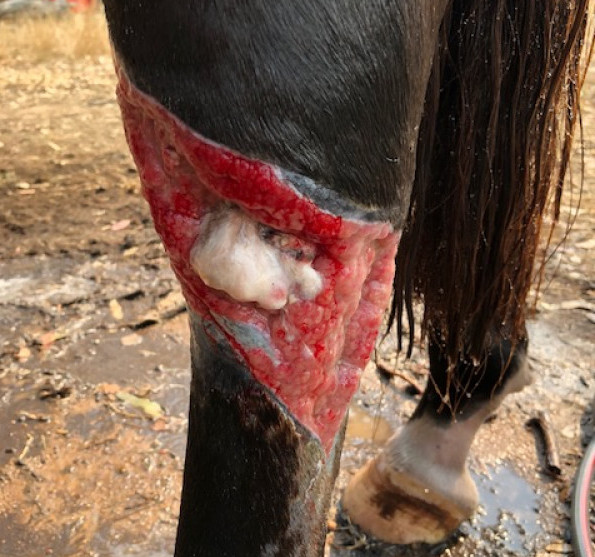Proud Flesh essentially occurs following a wound, injury or surgery when normal granulated wound tissue that is pinkish and succulant , overgrows around the wound. Later there may be evidence of irritation, infection or parasites...

As your horse's wound begins to heal normally, granulation tissue fills in the gaps between soft tissues. Granulation tissue naturally stops forming as the skin edges grow together to close the wound. But when healing doesn't go according to plan, the granulation tissue becomes exuberant-it keeps growing until it bulges above skin level, so newly formed skin can't grow over the wound. That's proud flesh.
Proud flesh tends to form in wounds below your horse's knees and hocks, where there's little soft tissue between skin and bone, and where movement constantly tugs the wound's edges. It's most likely to occur in places with lots of movement, such as over joints, or when a complication, such as infection, slows healing.
Wet weather can also be responsible for proud flesh which can be very much like a tropical ulcer. This is where you end up with a colony of superficial bacteria thriving in the moist warm environment. The proud flesh is self perpetuating through the colonies of infection that maintain the moisture to suit them selves. They typically occupy the edge of a wound and actually prevent the skin from growing across. In nature your horse will lick or even chew it away if he can get to it. The healing process needs to fight fire with fire.
The use of styptic substances historically was to dry wounds and seal off blood and other vessels so that a wound healed dry and not moist. I have a blend of Yarrow and Calendula extracts which I recommend are used on open wounds to promote drying and healing from the inside out.
This may be enough to bring the healing back on track. If not I recommend the following:
A tropical remedy to assist in clearing this sort of secondary infestation is to put the ripe flesh of the Paw Paw (Papaya) on the wound and the super high enzyme activity in the ripening flesh will eat away the topical infection, the wound will appear larger at first and then it will dry out and heal properly.
I recommend you first try the antispetic styptic drops directly in and around the wound and then if you are having trouble go back to the ripe Papaya first and then to the antiseptic styptic extract once the proud flesh is eaten away.
Further surgery and topical antibiotics are not going to help.




